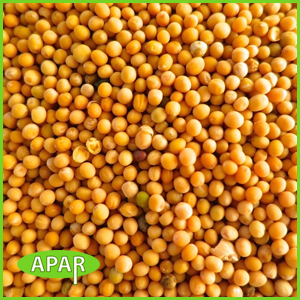YELLOW MUSTARD SEEDS
It was the condiment, not the plant, that was originally called mustard. The condiment got its name because it was made by grinding the seeds of what was once called the senvy plant into a paste and mixing it with must (an unfermented wine). Mustard is one of the oldest spices and one of the most widely used. The Chinese were using mustard thousands of years ago and the ancient Greeks considered it an everyday spice. The first medical mention of it is in the Hippocratic writings, where it was used for general muscular relief. The Romans used it as a condiment and pickling spice. King Louis XI would travel with his own royal mustard pot, in case his hosts didn’t serve it. Today, world consumption of mustard tops 400 million pounds.
Whole white mustard seed is used in pickling spice and in spice mixtures for cooking meats and seafood. It adds piquancy to Sauerkraut and is sometimes used in marinades. In India, whole seeds are fried in ghee until the seed pops, producing a milder nutty flavour that is useful as a garnish or seasoning for other Indian dishes. The brown seed is also pounded with other spices in the preparation of curry powders and pastes. Mustard oil is made from B. juncea, providing a piquant oil widely used in India in the same way as ghee. Powdered mustard acts as an emulsifier in the preparation of mayonnaise and salad dressings. Powdered mustard is also useful for flavouring barbecue sauces, baked beans, many meat dishes, deviled eggs, beets and succotash. There are many ready-made mustards from mild and sweet to sharp and strong.
An erect herbaceous annual. The white variety (B. alba) is hardy, growing to 80 cm (30 in), with hairy stems and lobed leaves. The bright yellow flowers yield hairy fruit pods, 2.5 – 5 cm (1-2 in) long, each containing about six seeds. Black mustard (B. nigra) is a larger plant than the white, reaching to 1 m (39 in). Some varieties reach double this height. The flowers are smaller, as are the fruit pods at 2 cm (3/4 in) long. Because of its height black mustard does not lend itself well to mechanical harvesting and since the seed is readily shed when ripe, there is too much waste for most commercial growers. As a result it has almost completely been replaced by the brown Variety. Brown mustard (B. juncea) is similar to black mustard in size. It is the rai of India. The leaves are ovate and the pods are 3 -5 cm (1-1/4 to 2 in) long. Mustard pods must be harvested before they burst, that is when they are nearly fully developed but not ripe.
Mustard plants are easy and inexpensive to grow; they flourish on many different types of soil, suffer from unusually few insect pests or plant diseases, and tolerate extremes of weather without serious harm.

